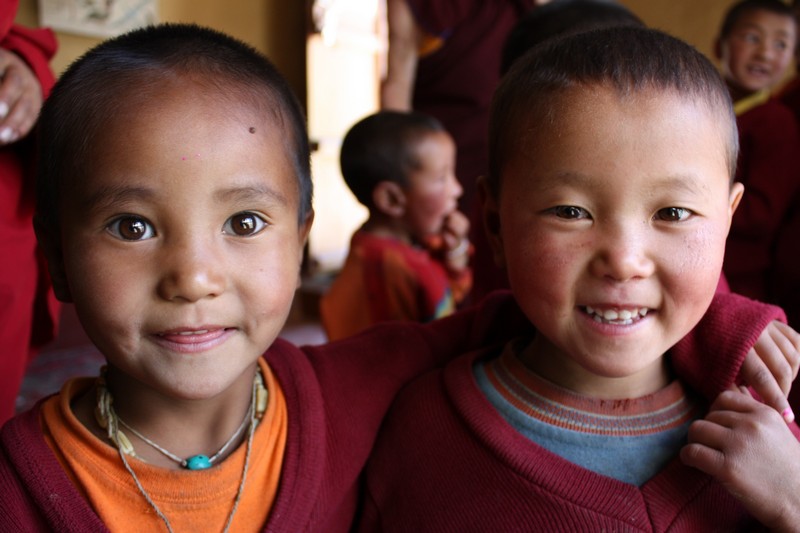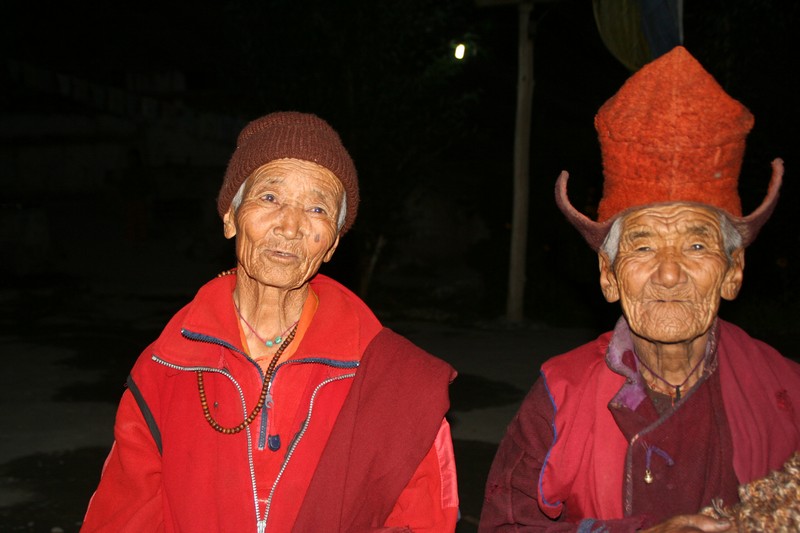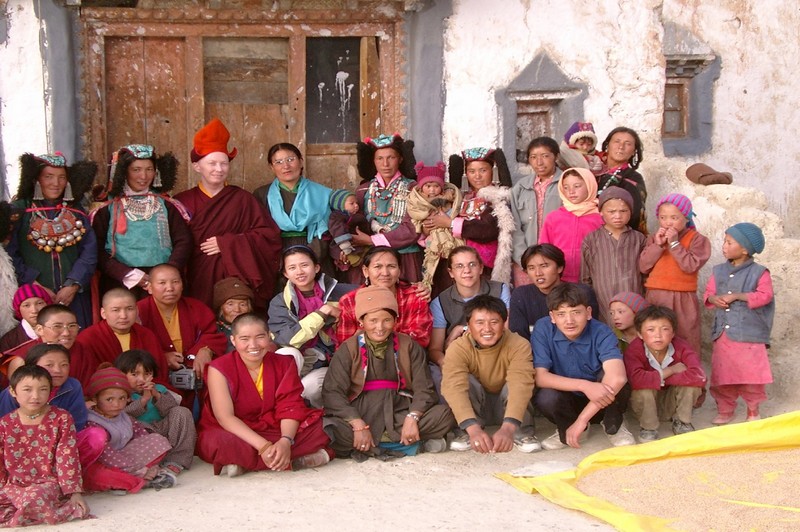Changchub Choling Monastary (Zangla)
From Padum, it is a one-and-a-half-hour journey to the village of Zangla. The road is a narrow track across a wide river bed by the Zangskar River, with high snow-covered mountains on either side. The road passes Stonde Gonpa, an impressive monastery for monks built on a rock face. The road though Zangla Village is in poor repair, with a water channel across the road, and it sometimes necessary to walk about 30 minutes to reach the monastery at the far end of the village. A large stupa (chorten) commemorating the nuns’ first teacher, stands at the entrance of the monastery. A range of buildings are scattered on the hillside, separated by neat paths and flower beds. Many trees have been planted and there is a greenhouse with an abundant supply of vegetables. The nuns have a cow and several dogs. Jamyang Foundation has provided financial support for Changchub Choling since 1989. Funds have been used to build a classroom, food for the nuns, and teachers’ salaries. A teacher in the village helps the nuns keep their accounts.
There are 18 nuns living in the monastery and 15 novices living at home who come during the day. Of the 18 nuns living in the monastery, 6 are under 30 and 3 are over 50. The youngest nun is 12 years old and the oldest is 78. One young nun related that her mother died and her elder sister is disabled and cannot work. She has 3 younger sisters and brothers. She lives at home and comes to the monastery daily for studies.
Most of the nuns had been nuns since their teens. Mostly it had been their own decision to become a nun, though some were encouraged by their parents. None of the nuns came from the very poorest families in the village. Most had not been to school, but had learnt Ladakhi from their fathers, lamas, or neighbors. Some of the younger nuns had studied up to grade 4, 6, or 8.
One nun, Lobsang Ngedron, received healthcare training at Sonam Norbu Memorial Hospital in Leh for a year and provides basic health care for the nuns. None of the nuns had been trained as amchis (traditionaldoctors), but there was one in the village.
The monastery has an impressive range of buildings, including an assembly hall, library, classroom, and adequate accommodations for the nuns, who each have two rooms. When novices are ordained, they hope that their families will build new rooms for them. Decisions regarding pujas and monastery administration are discussed by all the nuns. Officers include storekeepers (nyerpa), two cashiers, a chanting master (unze), and a sacristan (konyer).
Four Zangla nuns studied at Jamyang Choling Institute for Buddhist Women in Dharamsala for one year in 1988. With this inspiration, they wanted to establish a similar community for nuns in Zangla and so they invited Geshe Tenpa Lhundrup, a monk from Tibet, to teach them. After teaching the nuns Buddhist philosophy and Tibetan grammar for 12 years, Geshe-la died in 2000. In appreciation of his teachings, they set about trying to find another teacher. The monastery became a branch of CIBS (Central Institute of Buddhist Studies) in 2002.
The daily schedule for the nuns involves getting up at 4-5 am, and doing individual prayers, meditation, and chanting for up to an hour and a half. After breakfast, the nuns are free to do studies and chores. Since Geshe Tenpa Lhundrup died last year, the older nuns read Dharma texts in their rooms. Geshe-la had given them daily teachings in Tibetan language, handwriting, grammar, and literature as well as Buddhist texts, logic, philosophy, and psychology. The texts he taught included The Graded Path to Enlightenment (Lam Rim), Perfection of Wisdom (Prajna Paramita Hridaya) and Middle Way philosophy (Madhyamika).
In addition to traditional learning, the nuns have studied English and mathematics when volunteers have been available to teach them.
The younger nuns and novices from the village study with a monk from Upti, following the CIBS (Central Institute of Buddhist Studies) curriculum of Hindi, English, Ladakhi, and math. Classes are held from 10-12am and 1-3pm. At the local school, the medium of instruction is Urdu, severely disadvantaging the nuns. At midday, the nuns perform puja for an hour, followed by lunch together. In the evening they chant Tara puja for an hour and then prepare their own meals individually.
Exercise is gained through gardening and planting trees as well as walking in the area. Health problems are mainly headaches and colds in winter. Due to the harsh winter and altitude, only a few vegetables can be grown, such as radishes and potatoes in summer. Wild greens are collected from the fields and eaten with rice, lentils, and chapattis. In autumn, summer, and spring, some vegetables can be harvested from the greenhouse. Normally, meals consist mainly of tsampa porridge with a little dried cheese and no vegetables.
The origins of Changchub Choling Monastery are quite ancient and the older nuns have lived there ever since they became nuns. All the nuns appreciate living in the monastery, because this gives them more time for Dharma practice and pujas. They have no philosophy teacher at present and have asked Ven. Karma Lekshe Tsomo to help them find them one. Having a philosophy teacher is seen as a very important means to gaining merit for future lives, as enlightenment is regarded as a distant goal.
The nuns have limited contact with the community, though laypeople from the village visit occasionally. The nuns are asked to read texts for people in the village and are able to give informal teachings, though formal teachings are not requested. When someone dies, the nuns go to the family’s house to perform pujas and prayers. This represents a change from earlier times, when only monks were invited to do funeral services. The nuns’ status has noticeably improved since they have become educated.
Almost all of the nuns, along with Geshe Tenpa Lhundrup, attended the Sakyadita conference organised by Gelongma Karma Lekshe Tsomo in Leh in 1995. Two of the nuns attended the Vinaya training in Karsha in 1996 that was organised by Getsuma Tenzin Palmo.
Regarding their hopes for the future, the nuns express the hope that more young nuns will join the monastery. The nuns felt that, due to changes in society, not so many young girls are becoming nuns these days. In decadent times, young people do not seem as devoted to the Buddhist teachings.
Referring to the comments of His Holiness the Dalai Lama that monks and nuns need to be more involved in the community, we asked what sorts of training might be useful. The nuns felt that general education was very important and that short trainings will help them gain confidence.
We talked with a nun named Chamba, who was polishing her copper water bowls and making wicks for butter lamps in her room. During our meetings with all the nuns, we were struck and delighted by Chamba’s sense of humor and her lively energy when we met her in the fields and heard that she planned to visit the springs.
Chamba was born in Zangla village 67 years ago and had nine brothers and sisters. She became a nun when she was 11, at a time when there were 10 nuns. Ten years later, there were another 10 nuns, but never more than 20, due to the limited accommodation for the nuns. When she first came to the monastery, there were no trees, classroom, or new gonpa, which was built just 7 years ago. Back then, they lacked Dharma texts and statues, and the living accommodations were much more simple. Now each nun has two small rooms, including a kitchen and bedroom. Before becoming a nun, Champa worked with her parents caring for the goats, sheep and cows.
For Chamba, what is most significant for her as a nun is to realize the value of her practice. Her most significant practice is Lama Chodpa, the daily offering puja that expresses guru devotion. In her experience, combining Lama Chodpa with the visualisation of Tara is sufficient; no other practice is needed.
Chamba uses Tibetan traditional remedies to cure colds and coughs. After our interview, she was going to a spring by the Zangskar River to bathe and collect water and mud at the bottom of the spring that is considered beneficial for colds, pain in the bones, and other health problems. The mud could later be heated, just like purified butter, and applied with cotton or wool to pressure points. Another remedy is to heat dried, finely-ground cow dung in a cloth and apply it to pressure points. There were two amchis living in Zangla Village, but now there is only one. Most of the nuns rely on Chamba for traditional remedies.







